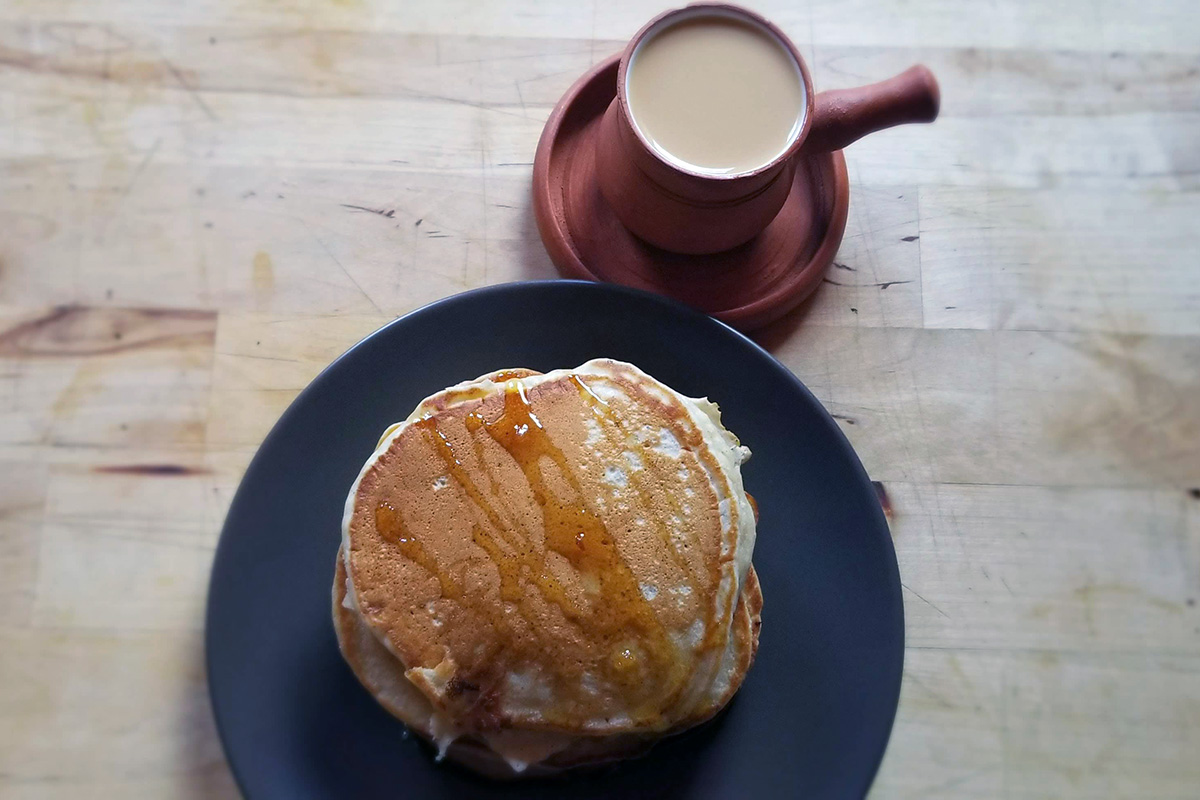Emirati Recipes: Chai Karak and Chbaab

Photo by Kathy Phung
Join us on July 5 as we explore the unique coffee traditions of the United Arab Emirates in our program, Coffee Break: Community, Conservation, and Culture. It’s okay if you prefer tea—we’ve got you covered! Try the following recipe for a taste of another important beverage in the UAE, chai karak.
With the discovery of oil in the 1960s, a wave of Indian immigration brought workers and their favorite spiced milk tea to the United Arab Emirates. The ubiquitous chai masala of the Indian subcontinent and culture has been tweaked a little in its new home in the UAE to become chai karak, meaning “hard” or “strong” in Hindi.
Chai karak, or simply, karak, has become a beloved staple of the Khaleej (Arabian Peninsula), to be consumed at any time of day. You can find it everywhere from specialized cafes to roadside stalls where drivers simply roll up, honk, and a server rushes out with a piping hot cup. Serving sizes range from small pick-me-ups to full mugs to be savored.
There is no definitive recipe as vendors have developed and fiercely guarded their own recipes, but, at minimum, cardamom is a starring, if not the starring spice, a strong black tea is the base, finished with a creaminess that can come from evaporated or condensed milk. Other spices that might be found in the secret recipes include ginger, cinnamon, cloves, or, in one such case, crushed Biscoff cookies.
The drink is emblematic of the global cuisines and cultures that make up the UAE. The rapid growth of the young nation attracted peoples from all over with world, who brought with them their traditions and cultures and created new roots. This recipe comes from Hanan Sayed Worrell’s Table Tales: The Global Nomad Cuisine of Abu Dhabi, which collects recipes from the varied inhabitants of the capital city.
Ahmed Al Bawardi, who contributed the recipe to Table Tales, suggests having karak with breakfast alongside freshly made chbaab, yeasted Emirati pancakes cooked on a tabi, a multipurpose metal disk perfect for open-fire cooking.

Recipe: Chai Karak (Cardamom Milk Tea)
By Ahmed Al Bawardi and Hanan Sayed WorrellIngredients
3 cups (700 ml) hot water
6 cardamom pods, crushed
3-4 teaspoons loose-leaf black tea
3/4 cup (180 ml) evaporated milk
2 tablespoons granulated sugar to taste
Pinch of saffron
Preparation
Combine the water, cardamom pods, and loose-leaf tea in a medium saucepan. If using teabags, cut open the bag to use the loose tea.
Allow the mixture to boil on high heat for 5 to 8 minutes or until aromatic, stirring regularly.
Turn the heat down to medium and add milk and sugar to taste. Increase the amount of milk for a creamier tea. Stir the chai karak until thoroughly heated, but don’t let the milk boil.
Remove from heat, cover, and let steep for 5 minutes. Strain the chai karak into a thermal carafe or teapot. As an option, add a few sprigs of saffron either to the carafe/teapot or the tea glasses.
Serve hot in small tea glasses or teacups.

Recipe: Chbaab (Emirati Pancakes)
By Ahmed Al Bawardi and Hanan Sayed WorrellIngredients
1 cup (150 grams) all-purpose flour
1 tablespoon granulated sugar
1/2 teaspoon yeast
1/2 teaspoon baking powder
1/4 teaspoon salt
1/2 teaspoon ground cardamom
1 egg, slightly beaten
1 cup (240 ml) milk
1 tablespoon cooking oil
Pinch of saffron
Butter or ghee
Preparation
Mix the flour, sugar, yeast, baking powder, salt, and cardamom in a small bowl.
Whisk the egg, milk, oil, and saffron in a medium bowl. Whisk the dry ingredients into the milk mixture until just moistened. For a thinner pancake, add more milk. Cover with plastic wrap and keep in a warm place away from drafts for 30 to 45 minutes.
Heat a griddle or a large skillet over medium-high heat. Add 1 tablespoon of butter or ghee and distribute it as it melts. Pour about 1/4 cup (60 ml) of batter onto the griddle for each pancake. Cook until bubbles form and a few have burst, about 1 to 2 minutes.
Flip with a thin spatula and let the other side brown for another 1 to 2 minutes. Repeat for all the batter.
Serve hot with honey, date molasses, brown sugar, or cheese.
Kathy Phung is the foodways coordinator for the Smithsonian Folklife Festival, who also manages the demonstration kitchen at the National Museum of American History. Armed with a degree in anthropology and baking and pastry arts, she has worked in various food enterprises in the D.C. area as an oompa loompa, pastry cook, and butcher.

